Books and reports
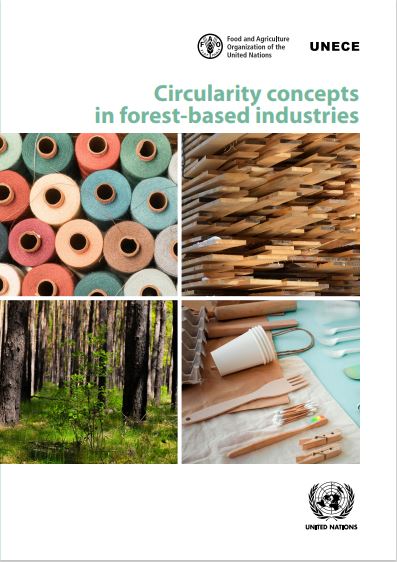
Circularity concepts in forest-based industries
This study analyses the existing and possible limitations to circular approaches in forest-based industries, namely the woodworking industry (focusing on sawn wood processing, bioenergy production and wood in construction), the furniture industry, the paper and pulp industry as well as industry using cellulose-based fibres and cellulose-based plastics.
The analysis provides evidence that not all circular approaches are sustainable under all circumstances. In some cases, the focus on circularity may cause environmental externalities, in other cases, it may not guarantee economic viability.
Aggestam, F., Kacprzak, A. and Wollnik, R. (2022) Circularity concepts in forest-based industries. Geneva: United Nations Economic Commission for Europe. [RIS file]
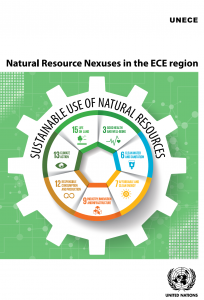
Natural Resource Nexuses in the ECE region
The nexus approach is a way of ensuring more integrated and sustainable perspectives of natural resource use beyond the traditional sectoral “silos”. This is an approach that can be applied at all scales. I have, together with colleagues in the United Nations Economic Commission for Europe (ECE), published a report that analyses seven nexus hotspots in an attempt to showcase specific challenges and opportunities for a nexus approach. This was done within a broader analytical framework, including regional megatrends and the SDGs, for the pan-European region.
Aggestam, F., Kit, P. & Tulsidas, H. (2021) Natural Resource Nexuses in the ECE region. Geneva: United Nations Economic Commission for Europe. [RIS file]

European forest governance post-2020
Forests and forest-relevant policies in Europe face a wide array of challenges in a rapidly changing world. Issues such as Brexit, the new European Parliament and European Commission, and the recent European Green Deal proposal are certain to affect policymaking, as are the as-yet unknown impacts of the coronavirus (COVID-19). A new science-policy study from EFI provides a timely look at forest governance in Europe, and offers insights into the potential way forward.
Wolfslehner, B., Pülzl, H., Kleinschmit, D., Aggestam, F., Winkel, G., Candel, J., Eckerberg, K., Feindt, P., McDermott, C., Secco, L., Sotirov, M., Lackner, M., Lazya Roux, J. (2020) European forest governance post-2020. From Science to Policy 10. European Forest Institute. Joensuu, Finland. [RIS file]
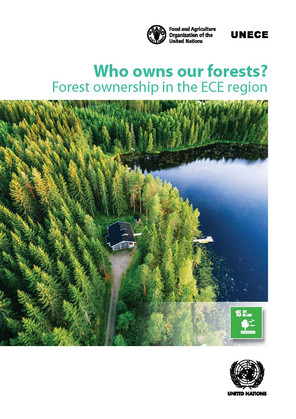
Forest ownership and the provision of wood and other forest ecosystem services
Forest ownership structures play an important role in the delivery of FES, so information about the forest owner and their forest land (e.g., forest management attitudes) can help to better understand the impact of different types of forest ownership types on forest use. For instance, the transfer of forest ownership through the restitution process in certain UNECE member States has not only changed national patterns of ownership but also affected how forests are being managed and utilized. Improving our knowledge about the relation between FES and forest ownership, public and private, can thus help to better understand the implications of these types of changes. Equally important for the provision of FES is the role of the State in defining how forests can be managed. Legal frameworks, ranging from implementing regulations, which for example set out property rights and tenure, and institutional regulations, which characterize the authorities/ institutions that manage public and private forests, are critical in defining forest ownership and use. Having these aspects in mind, this chapter analyzes the relationship between FES provision and forest ownership.
Aggestam, F., Quiroga, S., Suárez, C., Martínez, P., & Sarvasova, Z. (2020) Forest ownership and the provision of wood and other forest ecosystem services. In: UNECE (2020) Who owns our forests? Forest ownership in the ECE region. Geneva: United Nations Economic Commission for Europe. pp. 73-86. [RIS file]

Municipal forests
Municipal forests are common across the ECE region and have a long history with regards to forest management. However, it is noted that the overall focus of managing municipal forest areas has shifted away from being primarily productive forests towards different degrees of multi-functionality (e.g., including public health, conservation of biodiversity, provision of non-wood goods and services as well as protective functions). This presents new challenges when considering the management of municipal forests. For instance, urbanization is commonly highlighted as a significant driving factor affecting municipal forests as well as enhancing ecosystem services as part of managing public forests. This demonstrates one of the challenges facing municipal decision-makers in terms of balancing multiple objectives, and highlights the need to improve our understanding of the current state of municipal forests.
Aggestam, F., Krott, M., and Hauck, M. (2020) Municipal Forests. In: UNECE (2020) Who owns our forests? Forest ownership in the ECE region. Geneva: United Nations Economic Commission for Europe. pp. 155-159. [RIS file]

Study on progress in implementing the EU Forest Strategy
The aim of this study is to help build a knowledge base for the review of the EU Forest Strategy that was adopted by the European Commission in 2013. The EU Forest Strategy addresses 8 priority areas that were identified as being particularly relevant for forests and the forest-based sector until 2020. These priority areas address: (i) support of rural and urban communities, (ii) competiveness and sustainability of the forest-based sector and bio economy, (iii) forests and climate change, (iv) protection of forests and provision of ecosystem services, (v) information on forests and how they are changing, (vi) innovation and value-added products in forestry, (vii) coordination and cooperation in forest issues, and (viii) the global dimension of forests.
Wolfslehner, B., Aggestam, F., Pülzl, H., Hurmekoski, E., Kulikova, E., Lindner, M., Nabuurs, G.J., Pettenella, D., Arets, E.J.M.M., Hendriks, C.M.A., and Giessen, L. (2019) Study On Progress In Implementing the EU Forest Strategy. Brussels: European Commission. [RIS file]
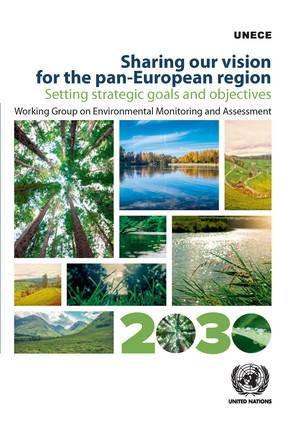
Sharing our Vision for the Pan-European Region
The UNECE Working Group on Environmental Monitoring and Assessment has been engaged in efforts to make environmental monitoring an effective instrument in policymaking and, in particular, to assist countries of Eastern and South-Eastern Europe, the Caucasus and Central Asia. UNECE member States, with the support of the secretariat, have made significant progress in establishing the Shared Environmental Information System, and there is a renewed and strengthened momentum for environmental monitoring and assessment following the Batumi Environment for Europe Conference. As a next step, the Working Group on Environmental Monitoring launched a collaborative and forward-looking discussion to define a vision for its work leading up to 2030, as described in this publication.
UNECE (2019) Sharing our Vision for the Pan-European Region. Geneva: United Nations Economic Commission for Europe. [RIS file]

Assessment framework of the Shared Environmental Information System
The Working Group on Environmental Monitoring and Assessment considered a revised assessment framework of the Shared Environmental Information System in 2019 and decided to finalize the assessment framework to be used for the final review of progress in establishing the Shared Environmental Information System in Europe and Central Asia, including the questions to be posed, the indicators and data flows to be reviewed and the application of the chosen scoring system. The present report provides the assessment framework for the review of progress in establishing the Shared Environmental Information System in Europe and Central Asia in advance of the next Environment for Europe Ministerial Conference.
UNECE (2019) Assessment framework of the Shared Environmental Information System. ECE/CEP-CES/GE.1/2019/3. Geneva: United Nations Economic Commission for Europe. [RIS file]

Mid-term review report on the establishment of the Shared Environmental Information System
The present document, prepared for the mid-term review of the Shared Environmental Information System in Europe and Central Asia, is based on an assessment framework developed by the Working Group on Environmental Monitoring and Assessment (see above), in close cooperation with the United Nations Environment Programme (UNEP) and the European Environment Agency. The mid-term review report is limited to seven data flows, covering three of the ECE environmental indicators, and builds on countries’ responses to the self-assessment questionnaire contained in the assessment framework, covering seven categories that are associated with data production and use of the ECE environmental indicator.
UNECE (2019) Mid-term review report on the establishment of the Shared Environmental Information System. ECE/CEP-CES/GE.1/2019/3. Geneva: United Nations Economic Commission for Europe. [RIS file]

Evaluation study of the forestry measures under rural development
The objective of this evaluation study of the Forest Measures under Rural Development was to carry out an evaluation of these measures, at the EU 28 level and for the present programming period 2014-2020. It covers 16 evaluation study questions (EQ) relating to: the drivers influencing the implementation choices taken by Member States/Regions and beneficiaries, as well as the effects of the measures production, geographical distribution; effectiveness (in relation to economic, environmental and climate objectives); efficiency; coherence; relevance; and EU added value.
Alliance Environnement, ORÉADE-BRÈCHE Sarl, IEEP and EFI (2018) Evaluation study of the forestry measures under Rural Development. Publications Office of the European Union, Luxembourg. [RIS file]
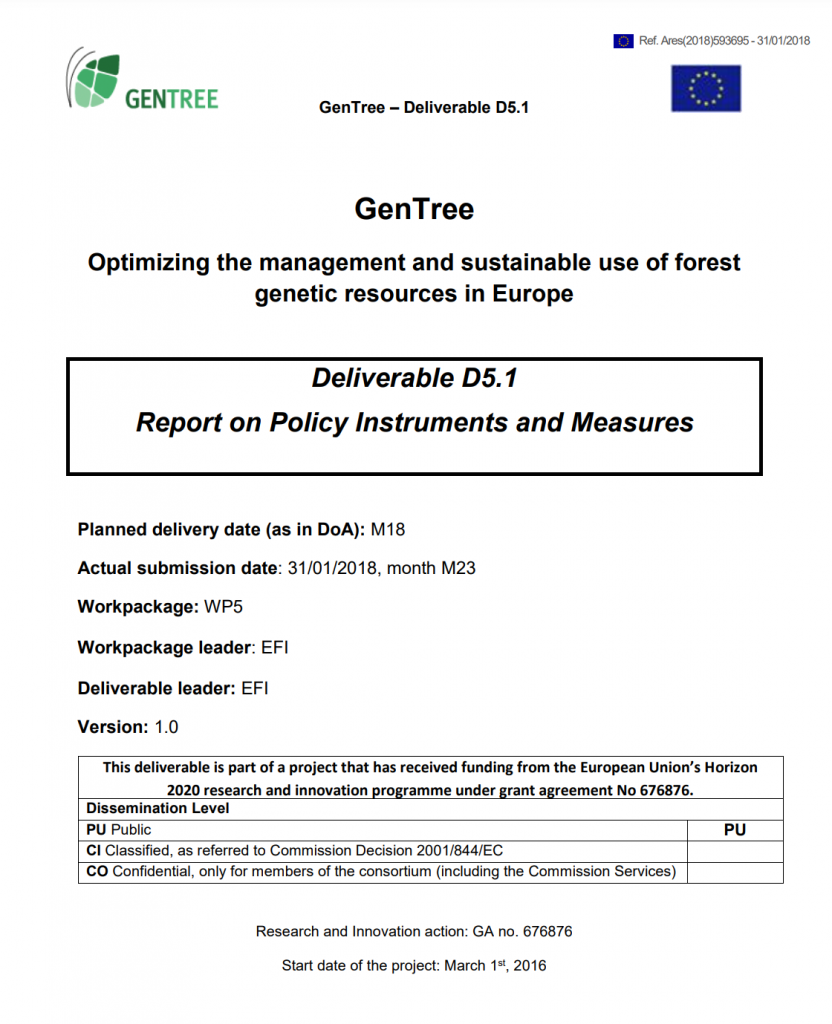
Optimizing the management and sustainable use of forest genetic resources in Europe: Report on Policy Instruments and Measures
Deliverable 5.1 is built on the GenTree Forest Policy Database and is an output of Task 5.3 – European and national policies affecting FGR: current situation and policy needs. This work is based on the recognition that there is a lack of information on EU policy frameworks affecting FGR conservation and management and in particular, on those policy frameworks that have an indirect impact. This lack of information limits the capacity of decision-makers to determine relevant policy actions needed on FGR.
Aggestam, F. (2018) Report on Policy Instruments and Measures. GENTREE - Optimizing the management and sustainable use of forest genetic resources in Europe. Deliverable D5.1. [RIS file]
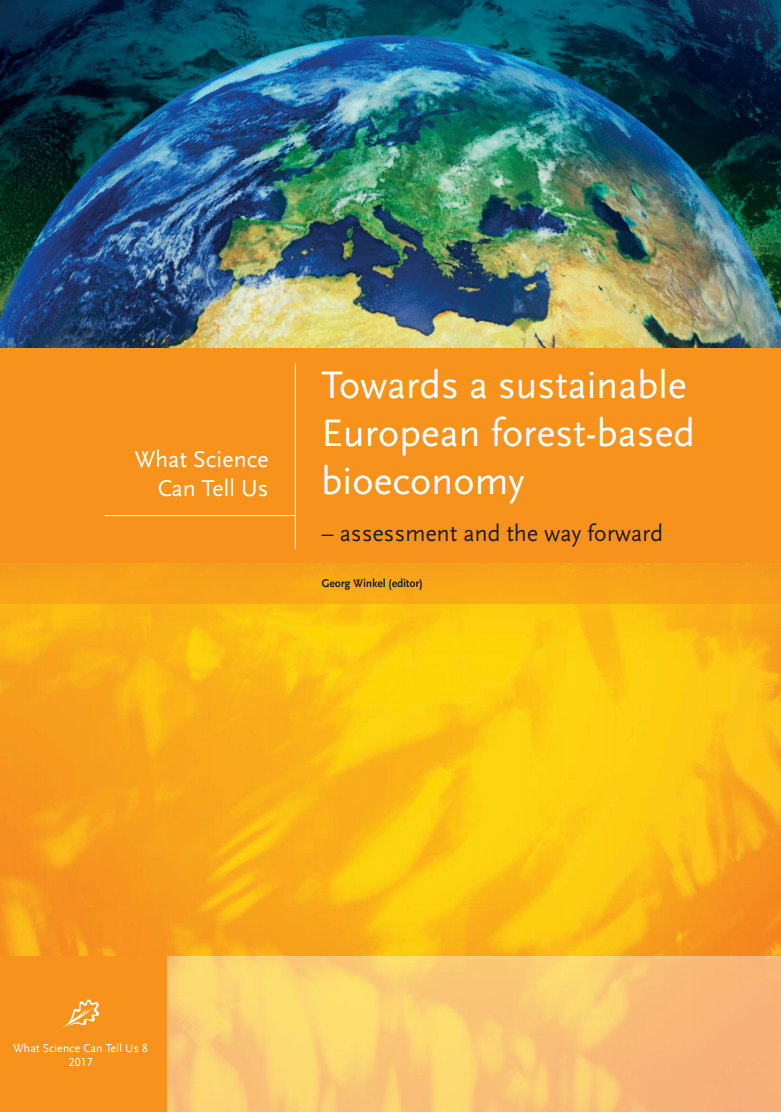
The EU policy framework
The bioeconomy has mobilised significant investments in technology, research and innovation. New and innovative bio-products and related services have emerged, and related niche markets show dynamic growth. The future of the bioeconomy, however, raises questions relating to its development potential, but also its sustainability. This What Science Can Tell Us study assesses the scientific evidence and provides a synthesis of existing knowledge for policymakers on the importance of forests and the forest-based sector in contributing to the future European bioeconomy. It assesses the economic, social and environmental sustainability of a forest-based bioeconomy, and looks at issues that may affect its development.
Aggestam, F., Winkel, G., Pülzl, H., Sotirov, M. (2017) The EU policy framework. In: Winkel, G. (Ed.), Towards a sustainable European forest based bioeconomy – assessment and the way forward. What Science Can Tell Us 8. European Forest Institute. [RIS file]

Report on progress in establishing the Shared Environmental Information System in support of regular reporting in the pan-European region
At the Seventh Environment for Europe Ministerial Conference (Astana, 2011) ministers decided that the pan-European environment should be kept under review by establishing a regular process of environmental assessment and developing a Shared Environmental Information Systems (SEIS) across the region. In accordance with that decision, the Economic Commission for Europe (ECE) Committee on Environmental Policy tasked the Working Group on Environmental Monitoring and Assessment with the review of progress in the establishment of SEIS. The present document responds to the Committee’s request. It was developed by the Working Group with support from the secretariat and in consultation with the European Environment Agency. The document aims to facilitate the ministerial discussion on keeping the pan-European environment under review.
ECE (2016) Report on progress in establishing the Shared Environmental Information System in support of regular reporting in the pan-European region. Environment for Europe. Geneva: United Nations Economic Commission for Europe. [RIS file]

An assessment of the cumulative cost impact of specified EU legislation and policies on the EU forest-based industries
This study consists of a cumulative cost assessment of the cost impacts of the most relevant EU legislation and policies for the EU forest-based industries (woodworking and pulp and paper) between 2005 and 2014. The EU legislation analysed was prioritised from over 100 acts and grouped in 8 policy areas or ‘legislative packages’. These included: competition, climate & energy, environment, forest-related, employment, product-related, transport, trade. (NB competition policy had no or negligible costs and trade policy was not very relevant for the woodworking sub-sector). In addition, an analysis of the industries’ cost structures was made in relation to key international competitors (Brazil, China, USA).
Rivera León, L., Aggestam, F., Bougas, K., Pülzl, H., Zoboli, E., Ravet, J., Griniece, E., Vermeer, J., Maroulis, N., Ettwein, F., Van Brusselenm J. and Green, T. (2016) An assessment of the cumulative cost impact of specified EU legislation and policies on the EU forest-based industries. Brussels: DG Grow. [RIS file]
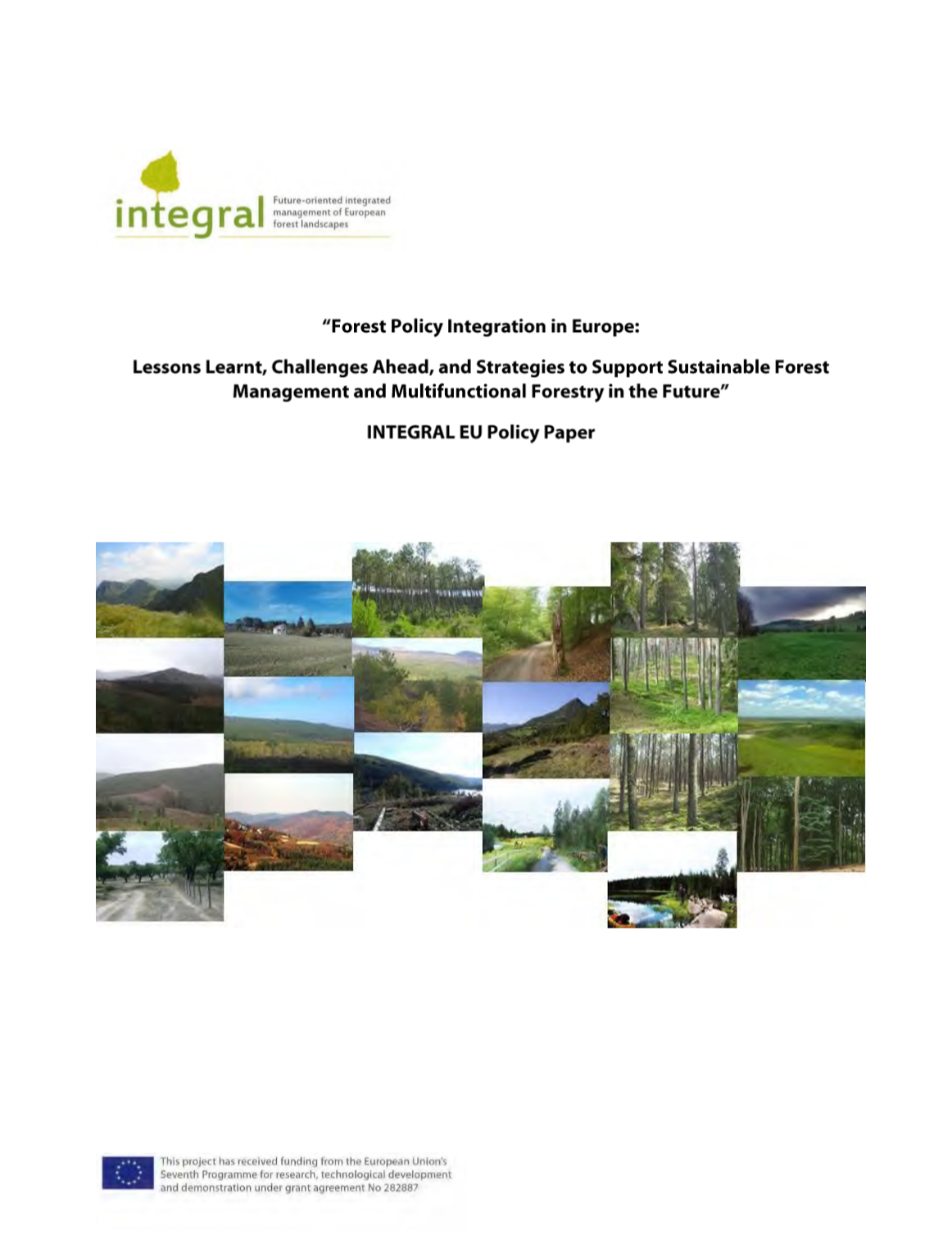
Forest Policy Integration in Europe: Lessons Learnt, Challenges Ahead, and Strategies to Support Sustainable Forest Management and Multifunctional Forestry in the Future
Sustainable forest management (SFM) has been broadly established as a policy objective in European and national forest policy and laws. However, for forest policy-makers, owners, managers, and stakeholder groups across Europe, one key challenge for implementing SFM in practice remains the integration of different forestrelated policy objectives and societal demands within the context of an uncertain and complex future. Hence, there is a need to identify and to implement policy and management responses that can help integrate different demands and objectives and anticipate and prepare for what the future has in store.
Sotirov, M., Aggestam, F., Storch, S., Giurca, A., Selter, A., Baycheva, T., Eriksson, L. O., Sallnäs, O., Trubins, R., Schüll, E., Borges, J., McDermott, C.L., Hoogstra-Klein, M., Hengeveld, G., Pettenella, D. (2015) Forest Policy Integration in Europe: Lessons Learnt, Challenges Ahead, and Strategies to Support Sustainable Forest Management and Multifunctional Forestry in the Future. INTEGRAL EU Policy Paper. Freiburg: University of Freiburg. [RIS file]
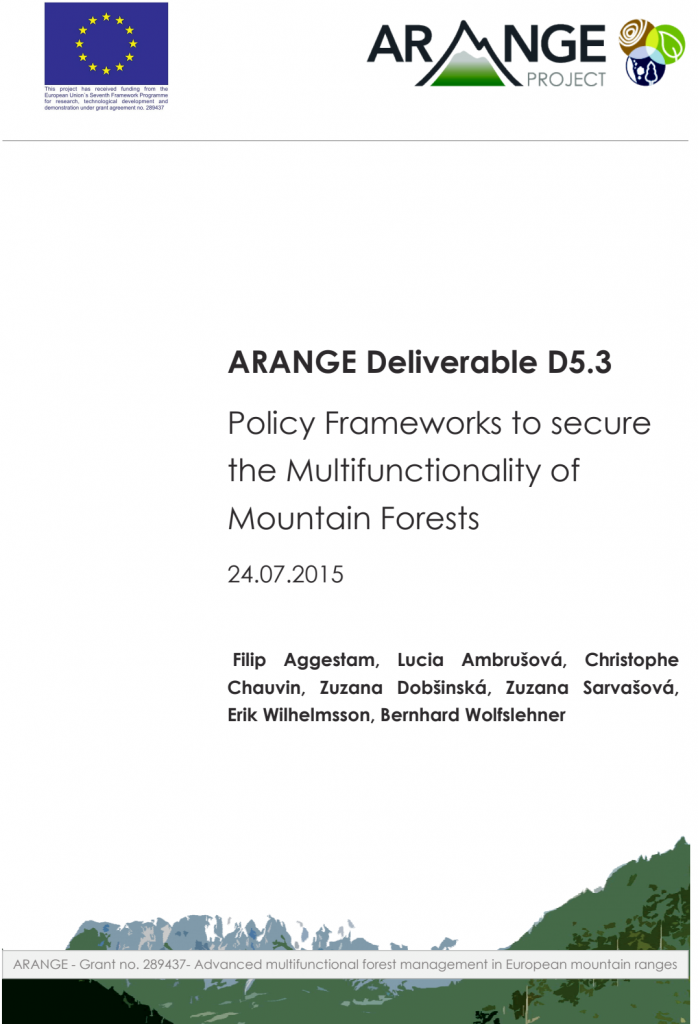
Policy Frameworks to secure the Multifunctionality of Mountain Forests
This report is concerned with summarising the current policy framework for mountain forest management aimed at ensuring the provision of the key ecosystems services and to identify options for further policy changes and their implications for multifunctional forest management, both on European and regional levels. It is, amongst other things, argued that the current platforms and instruments affecting mountain areas in Europe do not provide an effective or clear solution to promote multifunctional forest management, despite the fact that multifunctional forest management is already practically being implemented in all ARANGE case study areas. Some of the key issues that have been noted concerns the balancing of ecosystem services provision and the role of science; strengthening local stakeholder involvement; enhancing regional initiatives; and Payments for Ecosystem Services (PES), economic oriented market instruments and economic incentives.
Aggestam, F., Ambrusova, L., Chauvin, C., Dobsinska, Z., Sarvasova, Z., Wilhelmsson, E. & Wolfslehner, B. (2015) Policy Frameworks to secure the Multifunctionality of Mountain Forests. ARANGE Deliverable D5.3. [RIS file]
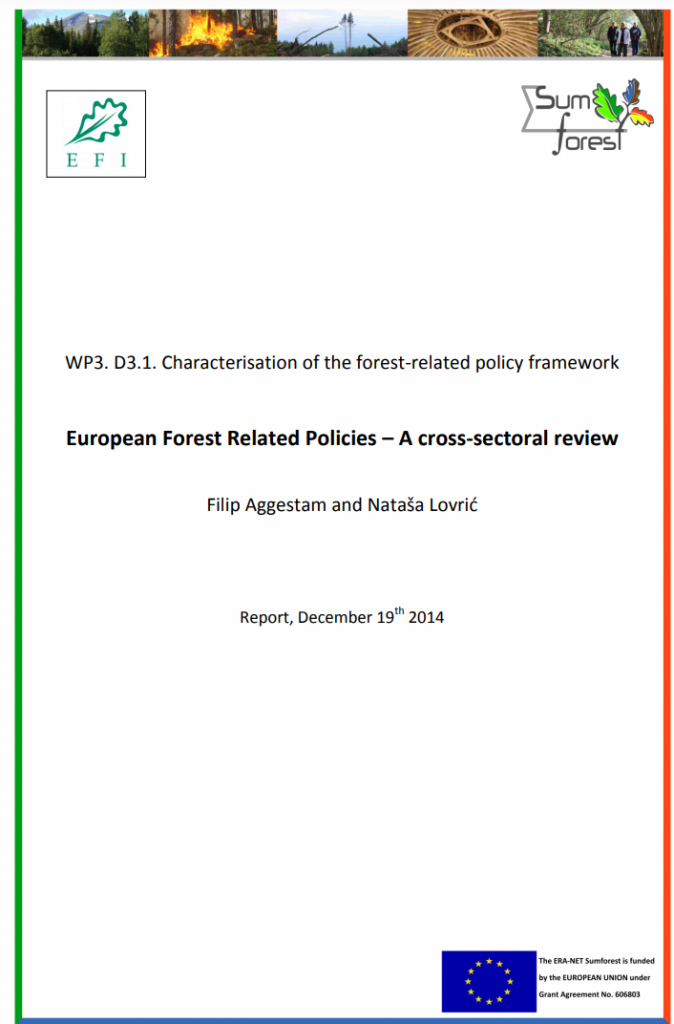
European Forest Related Policies: A cross-sectoral review
This report represents a concise description and characterisation of the European Union (EU) Forest policy related framework. Its aim is to improve the understanding of the forest-related policy framework by identifying and characterizing the EU Directives and International policies, directives and conventions affecting sustainable forest management and multifunctional forestry.
Aggestam, F. & Lovric, N. (2014) European Forest Related Policies: A cross-sectoral review. WP3. D3.1. Characterisation of the forest-related policy framework. SUMFOREST. [RIS file]
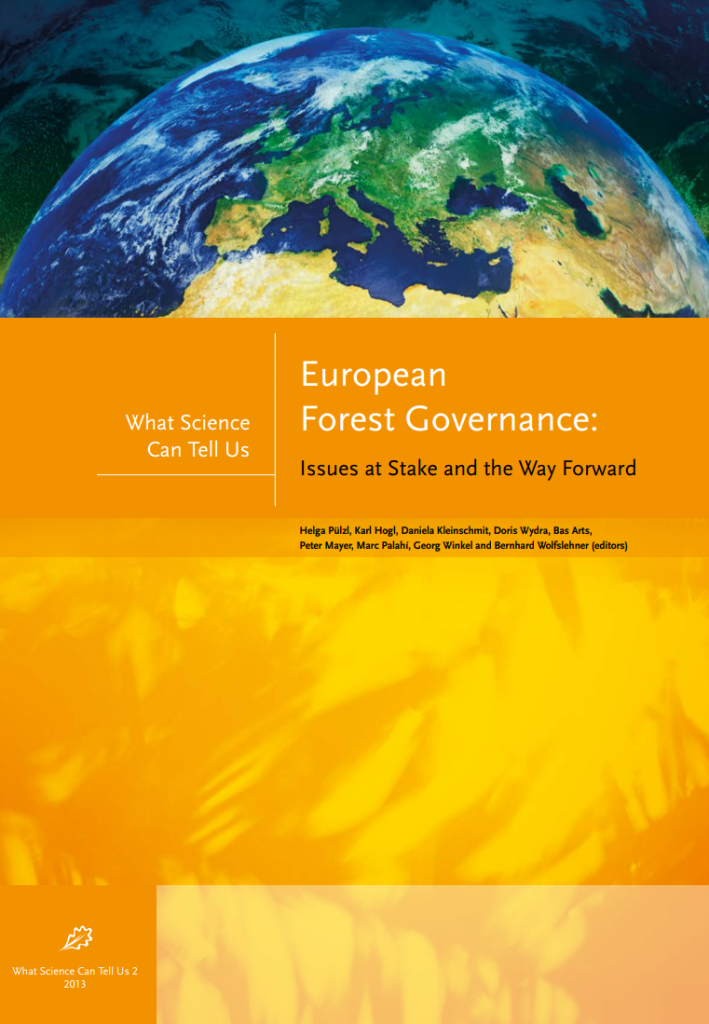
Forest Policy in the European Union
This chapter is part of a bigger report that provides a condensed and structured description and assessment of forest-focused and forest-related policies and of actor constellations at the European level. It covers pan-Europe and the European Union (EU) as policy arenas and does not analyse and discuss national forest policymaking and the ways in which European decision-making influences national policymaking.
Winkel, G., Aggestam, F., Sotirov, M. & Weiss, G. (2013) Forest Policy in the European Union, in: Pülzl, H., Hogl, K., Kleinschmit, D., Wydra, D., Arts, B., Mayer, P., Palahí, M., Winkel, G., Wolfslehner, B. (Eds.), European Forest Governance: Issues at Stake and the Way Forward, pp. 52-63. [RIS file]
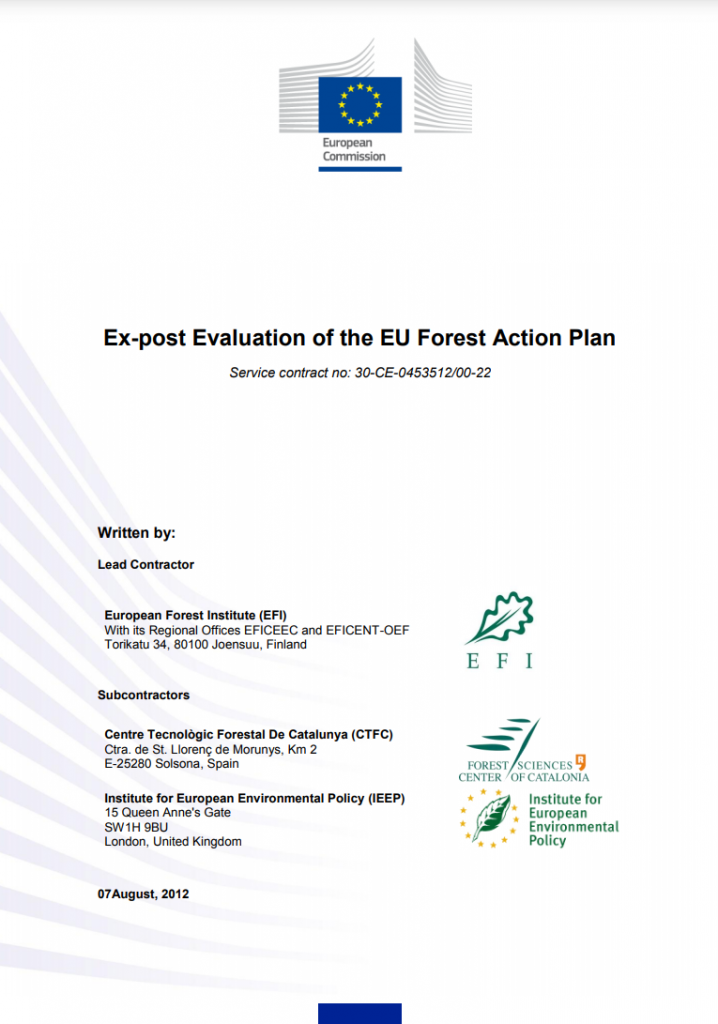
Ex-post Evaluation of the EU Forest Action Plan
The EU Forest Action Plan was the main instrument for the implementation of the first EU Forestry Strategy. The EU Forest Action Plan covered activities between 2007-2011 with the goal to contribute to long-term competitiveness, enhance and protect the environment, contribute to quality of life and improve coordination and communication. The aim of the ex-post evaluation was to review the implementation, effectiveness and appropriateness of the EU Forest Action Plan and to analyse whether the objectives of the EU Forest Action Plan have been met, the Action
Plan has led to any side effects, the instruments used are appropriate, relevant, effective and efficient and what was the role of the key actors. It also examined whether the EU Forest Action Plan was the most suitable framework for forest-related actions and instrument of coordination between the Community and Member States. This analysis was carried out in the light of key developments for the forest sector at Member State, European and international levels.
Pelli, P., Aggestam, F., Weiss, G., Inhaizer, H., Keenleyside, C., Gantioler, S., Boglio, D. & Poláková, J. (2012) Ex-post Evaluation of the EU Forest Action Plan. Brussels: DG Agri. [RIS file]
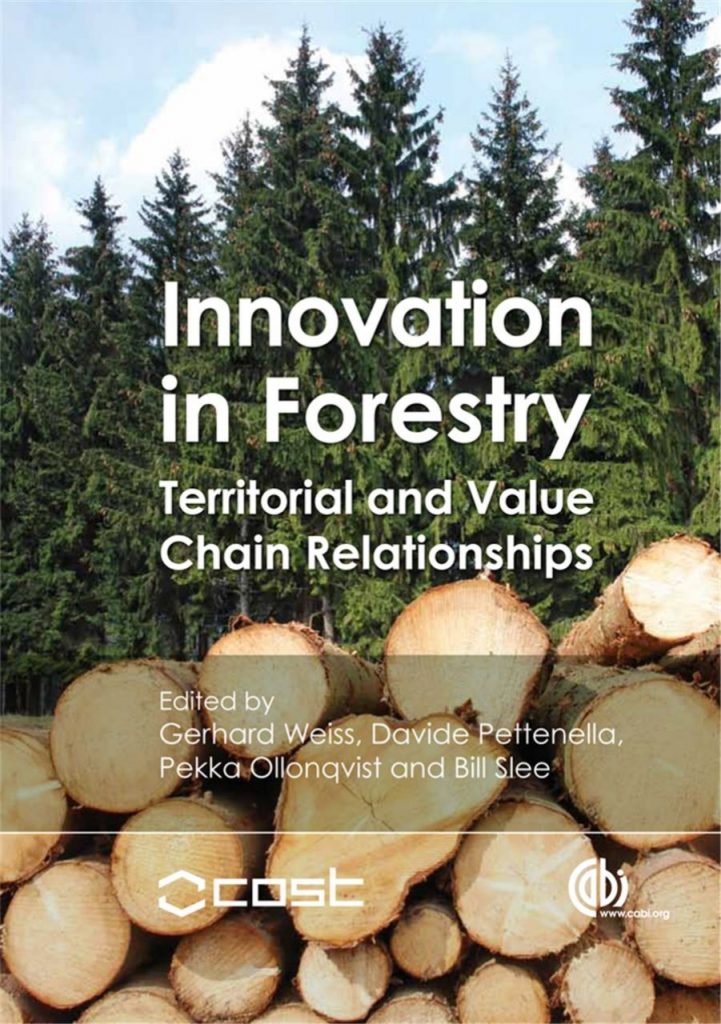
Innovation in EU Forestries: a Science–Policy Dialogue
This chapter analyses a cross-sectoral discussion forum – a science-policy dialogue – held at the final conference of COST Action E51. The design of the forum was as a moderated fishbowl discussion with invited discussants and the audience. The aim was to discuss the problem situation and possible strategies for policy improvements among researchers and policy practice. The discussants included policy makers and stakeholders from research policy, forestry, forest industry and regional development. The discussion forum was video recorded. This enabled the extraction and review of all major issues raised throughout the discussion, and the transcription of parts of particular importance. The main questions were directed at the success and gaps of current policies and which policy improvements are needed in order to support innovations in the sector and for rural development. These questions were discussed for territorial goods and services, and for the wood value chains. Results suggest a need for improving the interface between research and practice. Support for innovation should move away from project-based support to long-term cooperation and collaborative learning, and from a focus on research to the support of the whole innovation process and better interaction of all parts of the innovation system. Policy measures need to define characteristics and address different types of micro-, small and medium-sized enterprises (SMEs) such as innovative front-runners and/or traditional firms. For the forest sector, it is also relevant that rural development policy considers all sectors that interact in the landscape, is multi-layered and stimulates connectivity and integration at and between the appropriate levels.
Aggestam, F. & Weiss, G. (2011) Innovation in EU Forestries: a Science–Policy Dialogue. In: Weiss, G., Pettenella, D., Ollonqvist, P., Slee, B. (Eds.), Innovation in Forestry: Territorial and Value Chain Relationships. CABI, pp. 294-302. [RIS file]
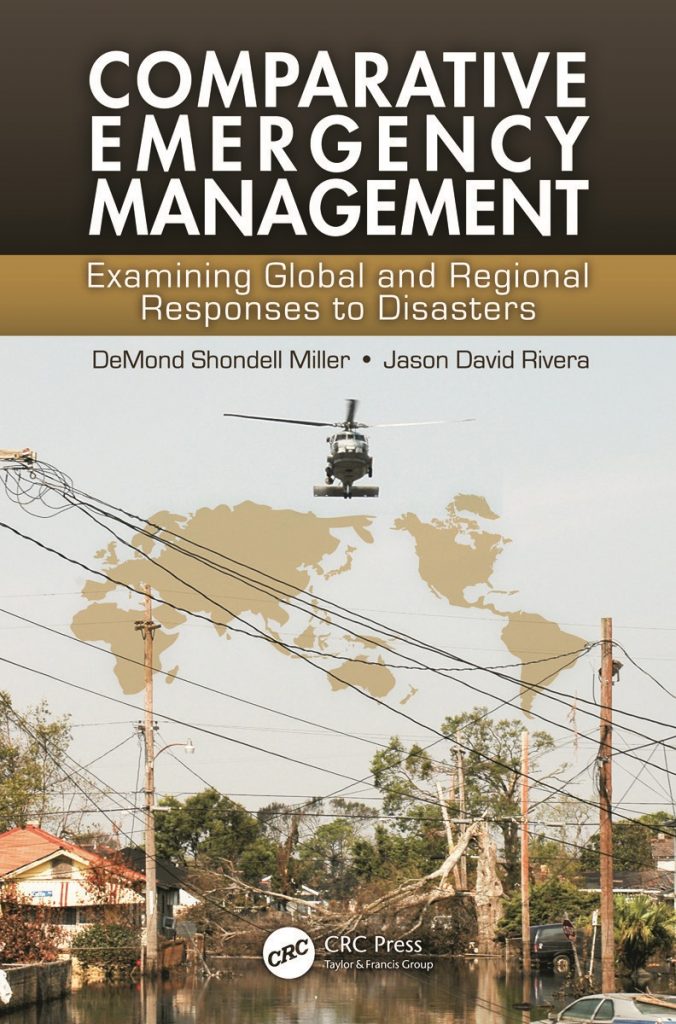
Critique of Stakeholder Participation and Decision-Making Processes Affecting the Design and Implementation of Transboundary Water Governance Projects Bordering Vulnerable/High Risk States: Lake Chad and Basin, Danube and Tisza River Basin
Using stakeholder participation and transboundary cooperation as a medium for analysis, this chapter explore their relevance to the concept of community-based disaster recovery and resilience. A brief overview of the relevant concepts employed throughout this study can be found in the appendices. The chapter presents two cases focusing on linking various aspects of participatory management with resilience and disaster recovery. Drawing conclusions in the context of international development interventions and the management of shared natural resources in risky ecosystems, the chapter presents a set of policy recommendations related to participatory management and transboundary cooperation.
Aggestam, F. & Hodge, S. (2011) Critique of Stakeholder Participation and Decision-Making Processes Affecting the Design and Implementation of Transboundary Water Governance Projects Bordering Vulnerable/High Risk States: Lake Chad and Basin, Danube and Tisza River Basin, in: Miller, M.S.R., D.J. (Ed.), Comparative Emergency Management: Examining Global and Regional Responses to Disasters. CRC Press, pp. 117-151. [RIS file]
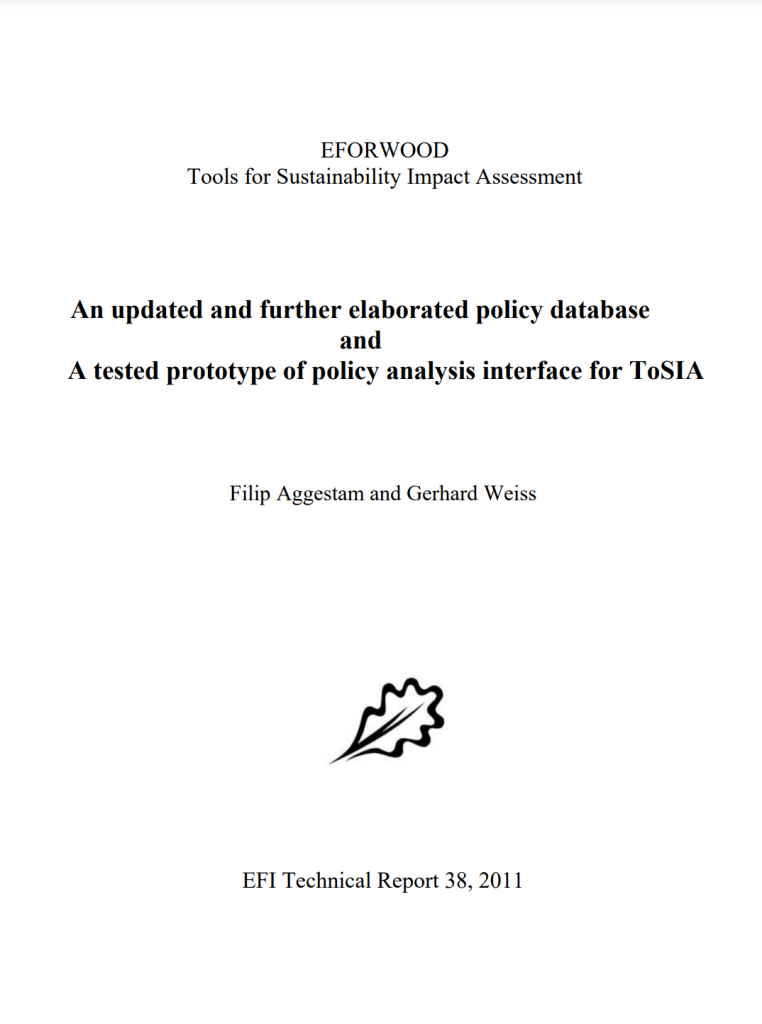
An updated and further elaborated policy database and a tested prototype of policy analysis interface for ToSIA
This report is a deliverable from the EU FP6 Integrated Project EFORWOOD – Tools for Sustainability Impact Assessment of the Forestry-Wood Chain. The main objective of EFORWOOD was to develop a tool for Sustainability Impact Assessment (SIA) of Forestry Wood Chains (FWC) at various scales of geographic area and time perspective. A FWC is determined by economic, ecological, technical, political and social factors, and consists of a number of interconnected processes, from forest regeneration to the end-of-life scenarios of wood-based products. EFORWOOD produced, as an output, a tool, which allows for analysis of sustainability impacts of existing and future FWCs.
Aggestam, F. & Weiss, G. (2011) An updated and further elaborated policy database and a tested prototype of policy analysis interface for ToSIA. EFORWOOD Deliverable D1.1.5. EFI Technical Report 38.
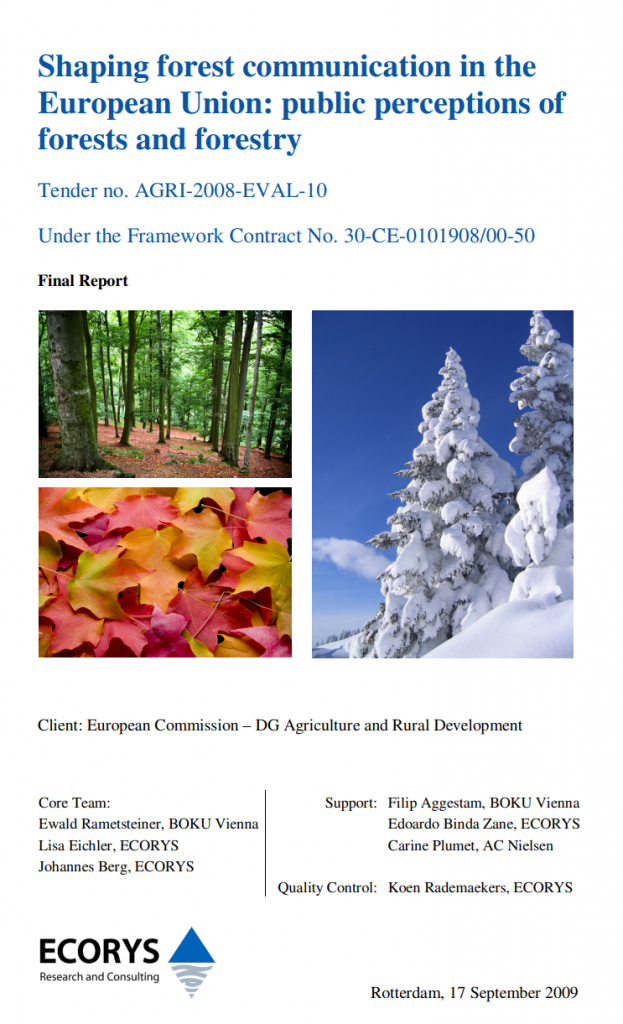
Shaping forest communication in the European Union: public perceptions of forests and forestry
The purpose of the study was fivefold: (1) to provide the Commission with a thorough analysis of existing surveys about public perceptions on forests and forestry in the EU; (2) to find out the views of key stakeholders (forestry experts, government officials, NGOs, forest owners, etc.) with regard to public opinion on forests and forestry and gather inputs on how public understanding and communication on the role of forests and forestry may be improved; (3) to apply the knowledge obtained to design, execute, and analyse the results of a public survey in the EU-27 countries; (4) to formulate conclusions on how public awareness of the role of forests and forestry in addressing new challenges in European society may be improved; and (5) to design a questionnaire which may be included in Eurobarometer surveys on public opinion in the EU.
Rametsteiner, E., Eichler, L., Berg, J., Aggestam, F., Binda Zane, E. & Plumet, C. (2009) Shaping forest communication in the European Union: public perceptions of forests and forestry. ECORYS, Final Report ed. [RIS file]